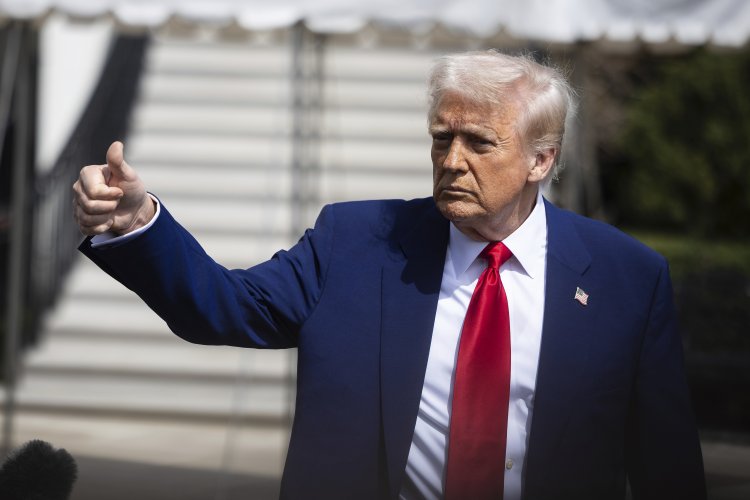Trump submits a harsh budget proposal; GOP lawmakers already dislike it.
The proposal to eliminate numerous domestic programs creates a conflict with Congress as the September 30 shutdown deadline approaches.

Released on Friday, the budget outline places pressure on Republican lawmakers to make cuts exceeding 20 percent from federal expenditures, which Trump has been freezing without congressional approval since he took office. Congress is unaccustomed to making cuts of this magnitude, increasing tensions between the White House and congressional Republicans as GOP leaders aim to secure government funding before the September 30 shutdown deadline.
Key Republican figures on Capitol Hill were quick to criticize the administration's proposal. Senate Appropriations Chair Susan Collins expressed her disapproval of the request to keep military funding at approximately $893 billion, pointing out the detrimental effects of the proposed cuts to biomedical research, educational support for low-income families, and assistance for vulnerable Americans struggling with heating and cooling costs.
Collins noted that the budget was "late" and missing "key details," and she raised "serious objections to the proposed freeze in our defense funding given the security challenges we face," in addition to the suggested cuts and "in some cases elimination" of non-defense programs.
Former Senate Republican Leader Mitch McConnell, now chair of the Senate's defense funding panel, criticized the White House budget office for proposing to keep defense spending static for the upcoming fiscal year. He remarked that the additional funding Republican leaders hope to include in their tax and spending megabill is "not a substitute for full-year appropriations."
"OMB accounting gimmicks may well convince Administration officials and spokesmen that they’re doing enough to counter the growing, coordinated challenges we face from China, Russia, Iran, North Korea, and radical terrorists. But they won’t fool Congress," McConnell added.
Senate Armed Services Chair Roger Wicker stated that the White House’s request would represent “a cut in real terms” for the military. He concurred with McConnell that the additional $150 billion in military funding that GOP leaders want to advance through a separate party-line package was not intended “to paper over” the White House budget office’s “intent to shred to the bone our military capabilities and our support to service members.”
Typically, Congress disregards the president’s budget requests in favor of its own. The House’s top appropriator has not committed to using Trump’s proposed totals as the cap for the funding bills House Republicans plan to push through committee by August.
“Look, we’re supportive of this administration, what it’s trying to do,” House Appropriations Chair Tom Cole told reporters. “But with all due respect to anybody, I think the members have a better understanding of what can pass and what can’t than the Executive Branch does.”
However, Trump could threaten to veto any funding proposals he finds unacceptable, and House fiscal conservatives are expected to insist that Speaker Mike Johnson commits to significant funding cuts. A senior official from the Office of Management and Budget indicated on Friday that the administration would not rule out utilizing impoundment to override Congress' funding decisions by withholding approved cash, although it has had productive discussions with lawmakers.
"We’re working with Congress to see what they will pass, and I believe that they have an interest in passing cuts," the official noted.
If Republicans consider aligning with the White House's plans, they risk losing the Democratic support they may need to navigate the next funding deadline, especially in the Senate, where they do not have enough votes to break a filibuster.
Democrats, on their part, are feeling increased pressure to resist the substantial cuts Trump is proposing. Following his political fallout in March for supporting the GOP’s last funding package, Senate Minority Leader Chuck Schumer pledged on Friday that “Democrats are going to fight this heartless budget with everything we’ve got,” describing Trump’s request as “a betrayal of working people from a morally bankrupt president.”
The fiscal 2026 spending plan introduced on Friday, commonly referred to as the president’s “skinny budget,” serves as an administration wishlist typically viewed as largely symbolic. Nevertheless, it outlines Trump's spending priorities and political aspirations—an agenda that has become crucial as he seeks to reclaim spending authority from lawmakers on Capitol Hill.
The long-standing adage on Capitol Hill—“the president proposes, Congress disposes”—holds less true this year, given that Trump has been canceling and freezing substantial amounts of funding without Congressional consent, resulting in lawsuits nationwide and 39 watchdog investigations into whether the Trump administration is unlawfully “impounding” funds previously enacted by Congress.
As Trump works to reshape the federal government early in his presidency, he has enlisted Elon Musk and the Department of Government Efficiency to cut spending in ways that have caused significant disruption. These moves have sometimes placed Trump at odds with congressional appropriators from his own party, setting the stage for an impending clash over government financing.
Trump’s latest budget proposal includes dramatic cuts to essential environmental, energy, education, and foreign aid programs for the fiscal year beginning in October, alongside significant reductions to hundreds of millions of dollars in grants and projects deemed “wasteful” by the White House. In some instances, the administration is advocating for the elimination of entire agencies.
At the same time, Trump is requesting Congress to boost funding for priority sectors such as border security, air and rail safety, and law enforcement initiatives.
In a letter to senior appropriators, White House budget director Russ Vought described the current government funding levels as “laden with spending contrary to the needs of ordinary working Americans.”
“Just as the Federal Government has intruded on matters best left to American families, it has intruded on matters best left to the level of government closest to the people,” Vought argued, advocating for the delegation of more responsibilities to state and local governments.
Against this backdrop, the budget proposal marks the White House’s most comprehensive attempt to cut federal non-defense discretionary spending to just $557 billion in fiscal 2026, representing a reduction of roughly $163 billion from existing levels.
Achieving these lower spending targets would result in extensive changes to domestic programs and foreign aid, including the defunding of Environmental Protection Agency initiatives dismissed as “environmental justice” efforts and significant cuts to millions of dollars in Department of Education grants intended for teacher support and preschool programs accused of promoting “critical race theory” and diversity, equity, and inclusion initiatives.
The White House is also pushing to close USAID and the U.S. Institute of Peace, two high-profile agencies recently targeted by the Department of Government Efficiency. The budget proposal outlines deep cuts to public health agencies within the Department of Health and Human Services, including the National Institutes of Health and the Centers for Disease Control and Prevention, in addition to a consolidation of smaller health offices—aligning with earlier leaked budget documents detailing plans for a sweeping department-wide reorganization.
The blueprint suggests reducing discretionary funding for the Department of Housing and Urban Development by over 40 percent. The Department of the Interior and the Department of Labor would also face significant budget reductions of over 30 percent compared to their current levels.
Detailed cuts across various offices and agencies include those affecting State Department programs intended to promote U.S. soft power abroad, NASA scientific initiatives, support for the International Space Station, and numerous conservation efforts.
Later this month, the White House is expected to submit a comprehensive budget request containing hundreds of pages detailing proposed funding for each program and agency, providing Congress with far more extensive guidance than the 46-page document they received on Friday.
Ramin Sohrabi for TROIB News












